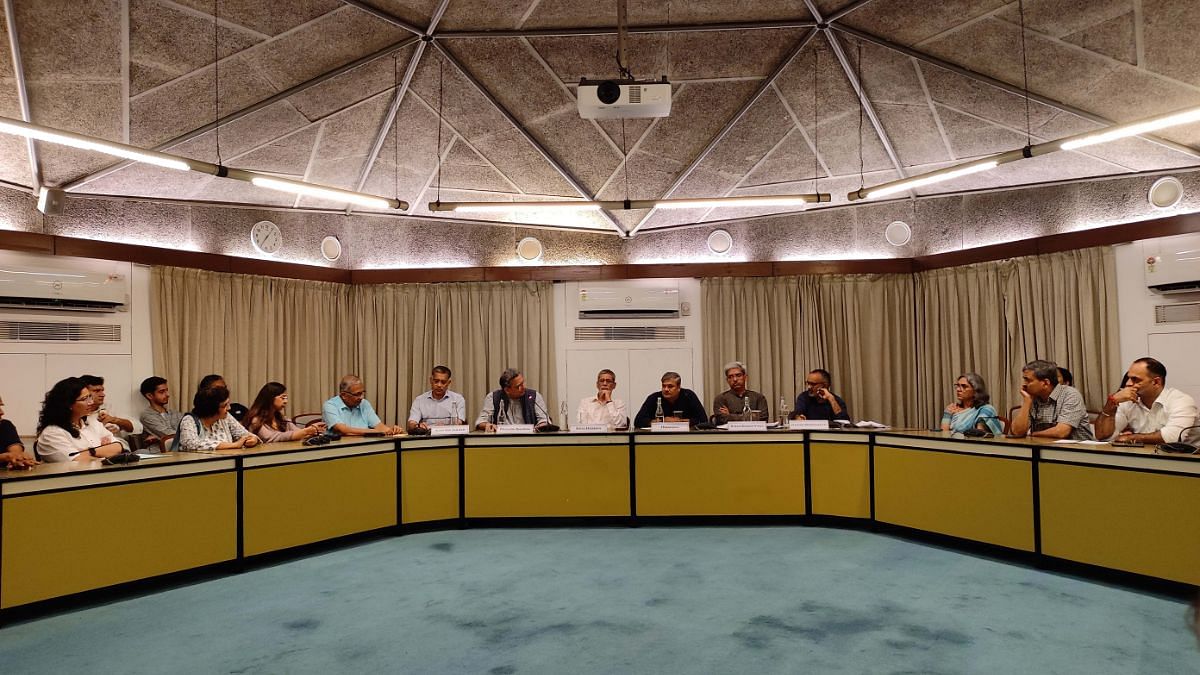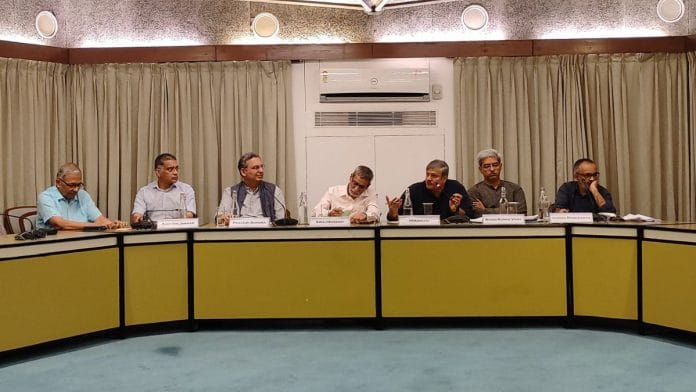New Delhi: Since the protests against the three farm laws began in November 2020, farmers have repeatedly taken to the streets, demanding a legal guarantee for MSP or minimum support price. According to farmer leaders, over 700 farmers died during the agitation. Four years later, a panel discussion among agriculture experts revealed that the issue remains mired in ambiguity, with no resolution in sight.
“Ambiguity around legal MSP arises from several concerns: what farmers expect [from MSP], how much it will cost, how it will be implemented, whether it will ensure dignified livelihoods, and most importantly, how it will impact food inflation,” said Ajay Vir Jakhar, chairman of Bharat Krishak Samaj.
The discussion, hosted by the India International Centre on 30 August, centred on the question, “Is the Legal Guarantee of MSP the Next Big Idea in Agriculture?” Along with Jakhar, the panel consisted of Kiran Kumar Vissa, national convener of the Alliance of Sustainable and Holistic Agriculture (ASHA); Harish Damodaran, rural affairs and agriculture editor at The Indian Express; and Himanshu, economics professor at Jawaharlal Nehru University (JNU).
Moderated by former IAS officer Pravesh Sharma and chaired by former civil servant Siraj Hussain, the event was attended by the secretaries of telecom, food, and agriculture; the chairman of the National Dairy Development Board (NDDB); the secretary of the North Interstate Council; and the director general of statistics.
Ambiguities abound
There is widespread ambiguity about MSP among farmers. They want a legal guarantee so that traders who buy below the minimum price are penalised, but this would negate the price discovery mechanism.
“Basing MSP on agro-climatic conditions could potentially cause issues, as farmers may prefer to grow the most profitable crops. This could lead to unrest if the government only incentivises specific crops that are suitable for a region,” Jakhar said.
An audience member highlighted MSP’s long-term negative ecological and economic effects, particularly in Punjab and Haryana, arguing that it has distorted cropping patterns. Vissa replied, “The [crop] imbalance in Punjab and Haryana is due to the non-implementation of MSP across the 23 declared crops.”
Vissa emphasised that implementing MSP across a diverse basket, including pulses, millets, and oilseeds—instead of just wheat and rice—would promote better cropping systems. While MSP is not a silver bullet, it remains a vital part of ensuring fair prices and income security for farmers.
When Sharma argued that MSP has outlived its purpose given India’s food self-sufficiency, Himanshu disagreed, mentioning India’s large imports of pulses and edible oil. He stressed that even in cases of surplus production, MSP remains crucial to prevent price collapses and protect farmers.
According to Himanshu, the existing MSP is merely “a tool for the NFSA [National Food Security Act, 2013]” that predominantly benefits crops such as wheat and rice, and regions like Punjab and Haryana. He advocated for the expansion of the MSP to cover a broader range of crops and regions, so it can provide equitable support to Indian farmers.
Also read: India wasn’t ready for Naina Dalal’s nude paintings in 1960s. At 90, she gets her solo exhibition
Legal guarantee
According to Harish Damodaran, there is no viable alternative to MSP. “By legalising it [MSP], we are doing ourselves a favour, not to the farmers,” he said. Damodaran expressed concerns about the declining number of farmers in India due to the crisis in the agriculture sector.
He added that MSP has no meaning without a legal guarantee, citing a gap between the declared MSP and the actual prices received by farmers: Rs 49,000 crore in 2018 and Rs 26,400 crore in 2022-23.

Kiran Kumar Vissa argued that MSP should fully cover cultivation costs and recommended market intervention schemes and a price deficiency payment system to ensure farmers receive the promised MSP.
However, Jakhar pointed out that a legal guarantee for MSP poses several practical challenges.
“A legal MSP will inevitably lead to a cascading effect on the cost of a thali,” Jakhar said. “With 44 per cent of the population reliant on agriculture and the states on the brink of bankruptcy, while the central government continues to borrow heavily, this issue demands urgent attention.”
He outlined critical aspects that need to be addressed before legalising MSP, such as potential cost implications, the effectiveness of MSP in providing dignified livelihoods, and its impact on food inflation.
Jakhar also noted that MSP cannot be practically implemented for perishable crops due to their short shelf life and the complexities involved in their marketing and distribution. Therefore, improvements in infrastructure and supply chain solutions will need to precede the expansion of MSP to include perishable crops.
A former food and agriculture secretary pointed out that guaranteed MSP must be implemented by both the Union and state governments.
Also read: Every Delhi house has a story to tell—the Mughals, Partition and migration
MSP is not a cure-all
Jakhar acknowledged the importance of a legal guarantee for MSP but suggested that the sector’s focus should shift toward improving the quality of life for farmers. “We should fight battles that can be won,” he said.
He explained that the disparity between farmers’ earnings and the prices paid by consumers stems from governance issues. This gap can be reduced through regulated markets, proper enforcement of policies, and accountability from all stakeholders—from government and regulators to traders and farmer organisations. Jakhar also noted that farmers need effective price discovery mechanisms and price risk insurance.
Damodaran criticised the current government’s approach of combining welfarism with agriculture and argued for a clear separation between the two. He stressed that farmers should be treated as businessmen deserving of fair compensation for their produce, instead of being subjected to inadequate payments from welfare programmes like the Pradhan Mantri Kisan Samman Nidhi (PM-KISAN).
“The PM-KISAN claims that there are 11.5 crore farmers in India, but the actual number of people engaged in farming may not be more than 4 crore,” he said.
He called for a ban on converting agricultural land for non-farming purposes, warning that the ongoing urbanisation of fertile lands poses a severe threat to India’s food security.
Vissa mentioned another problem with the agriculture sector: A significant portion of farming in India is carried out by tenant farmers. They make up about 50-60 per cent of total farmers in Andhra Pradesh and Uttar Pradesh, and 36 per cent in Telangana. Many government schemes are tied to land ownership, which fails to support these tenant farmers effectively.
“Farming is in an existential crisis and farmers are in an economic crisis,” Vissa said.
(Edited by Prasanna Bachchhav)






